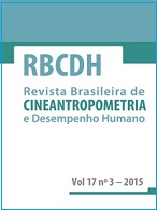Tracking and its applicability to Physical Education and Sport
DOI:
https://doi.org/10.1590/1980-0037.2015v17n3p337Abstract
Tracking refers to the idea of maintaining a relative position within a given group of individuals as they change in time. This paper presents several approaches to study and analyze tracking (i.e., stability and predictability) and its application in physical education and sport. We will use data from a mixed-longitudinal study conducted in the city of Porto, Portugal, comprising 486 girls that were divided into two age cohorts: 12-14 years and 14-16 years. Body mass index (BMI) was the chosen variable in all statistical analyses of tracking. Statistical techniques to describe tracking included: autocorrelations, Foulkes & Davis gamma and Goldstein constancy index. Regardless of statistical procedure used, tracking BMI was moderate to high in each cohort, which could be due to the short follow-up period. However, each tracking statistics showed different aspects of inter-individual differences in intra-individual changes of girls’ BMI. The use of any of the suggested procedures to study aspects of stability and predictability (i.e., tracking) in longitudinal studies requires a careful scrutiny of main goals and hypotheses to be tested.



